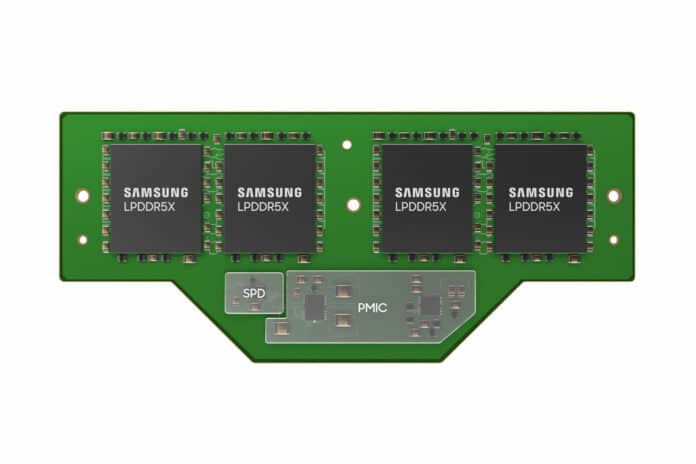Historically, PCs and laptops have conventionally used LPDDR DRAM or DDR-based So-DIMMs.
Low Power DDR (LPDDR) memory has played a pivotal role in reducing power usage in PCs and laptops. However, one of the major drawbacks of this mobile-focused memory is its tight signaling and power delivery requirements. Designed to be placed close to its host CPU to minimize power expenditures and maximize clock speeds, LPDDR memory requires being soldered on the device’s motherboard. This makes it challenging to replace during repairs or upgrades.
On the other hand, So-DIMMs (Small Outline Dual In-line Memory Module) can be attached or detached easily but have limitations with performance and other physical features.
Samsung Electronics, one of the world’s largest producers of electronic devices, has announced the industry’s first Low Power Compression Attached Memory Module (LPCAMM), which is expected to overcome the shortcomings of both LPDDR and So-DIMMs.
The 7.5 gigabits-per-second (Gbps) LPCAMM is a detachable module that offers enhanced flexibility for PC and laptop manufacturers during the production process. Compared to So-DIMM, LPCAMM occupies up to 60% less space on the motherboard, paving the way for smaller, thinner, and lighter designs.
In addition, it offers up to 50% higher performance and up to 70% higher power efficiency, both of which are key criteria for ensuring next-gen mobile systems deliver on performance and battery life even while they shrink to ever-smaller form factors.
For their first generation of dual-channel Samsung LPCAMMs, Samsung is looking at 32GB, 64GB, and 128GB capacities, offering a significant amount of memory in a compact and innovative new design.
LPDDR’s power-saving features have made it an attractive option for servers, as it could potentially improve total cost of operation (TCO) efficiency. However, using LPDDR can create operational difficulties, such as the need to replace the entire motherboard when upgrading a server’s DRAM specifications. LPCAMM offers a solution to these challenges, creating significant potential for it to become the solution of choice for future data centers and servers.
According to Samsung, they’ve already verified their LPCAMMs through Intel’s platform. While there is nothing vendor-specific about LPCAMMs, if this form factor proves to be successful, it won’t be surprising to see laptop manufacturers adopting it for AMD designs as well.
“The energy efficiency and repairability advantages of LPCAMM make this new form factor a game changer in today’s PC market,” said Dr. Dimitrios Ziakas, Vice President of Memory & IO Technology at Intel.
“With the growing demand for innovative memory solutions encompassing high performance, low power consumption, and manufacturing flexibility across various fields, LPCAMM is expected to gain wide adoption in PCs, laptops, and data centers,” said Yongcheol Bae, Executive Vice President of Memory Product Planning Team at Samsung Electronics, in an official statement. “Samsung is committed to actively pursuing opportunities to expand the LPCAMM solution market and collaborating closely with the industry to explore new applications for its use.”
Samsung’s LPCAMM is set to be tested using next-generation systems with major customers this year. If all goes according to plan, the company expects to commercialize LPCAMMs in 2024, which should line it up to ship in systems based on Intel’s next-generation Meteor Lake platform.
